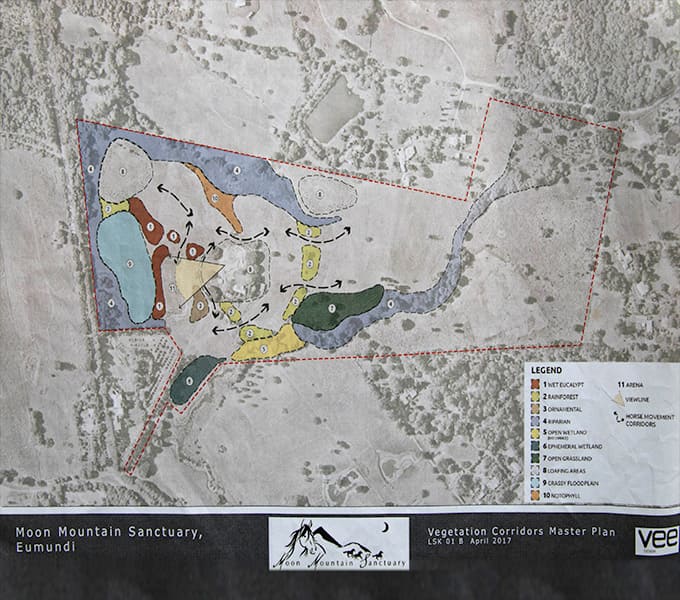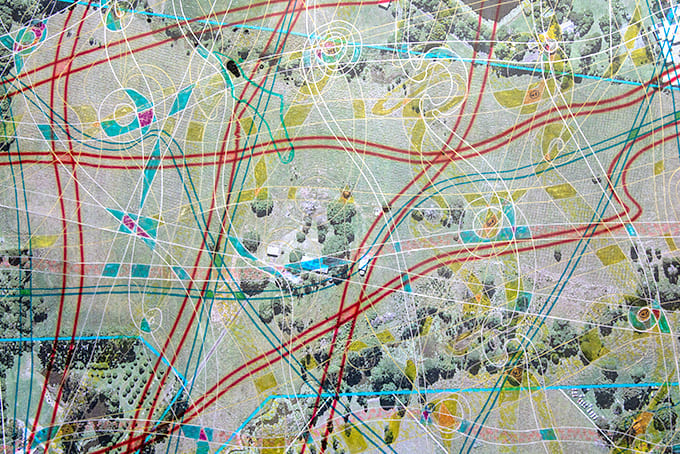Re Wilding
Moon Mountain is today a place of wildness as the regeneration of forest, waterways, wetlands and grassed areas encourage wildlife to return. Working to create core areas where the natural processes are allowed to create a diversity of vegetation to encourage the return of wildlife. Nature is allowed to reclaim core areas of the property with landscape corridors and stepping stone islands of vegetation linking the core areas. Surrounding these are the modified human lands where both the horses and wildlife forage for food.
Map of the regeneration plan
Mount Cooroy towers over the farm and influences the energy, the light, the weather and life of the farm. The sheer monumental scale and energy of the volcanic cone would have held great significance to the traditional owners of the land, the Kabi Kabi (Gubbi Gubbi). The Gubbi Gubbi people lived with this land for thousands of years before the catastrophic arrival of the white mob, who cleared the farm of the original rainforest vegetation. Changing the landscape forever.
Many of the Kabi Kabi stories and song lines have been lost due to the policies of past governments. The mountain is so powerful that the Kabi Kabi would have established pathways to the mountain. Locals have long held the belief that this was the location of the birthing rock for Kabi Kabi women.
We can identify, with the help of geometrics the energy lines and magnetic fields that crisscross the farm. These may or may not follow the song lines of the Kabi Kabi, we will never know but we can in our work with the land follow and respect the energy lines and magnetic fields. Armed with a complex map of the energy lines, Lynn and Ron have used this knowledge to locate the core areas and corridors and stepping stones for nature to reclaim the land.


Map of Energy lines
Rewilding is gaining momentum as a more inclusive way to look at utilising the landscape but its application to the Australian landscape faces different constraints to that of the movement in Europe and the USA. The three guiding principles of Core reserves (the wild), corridors (connectivity) and carnivores (keystone species) has required that we rethink the role of keystone species. We lack the carnivore keystone species of lions, panthers, jaguars, wolves, bears. Lynn and Ron encourage wildlife to return to the farm and it is. Dingoes still visit the farm being captured on night cameras but today are breeding with wild dogs.
We now are rethinking what constitutes a keystone species. For us, the use of the term Focal Species has more relevance to Australia. Except in our oceans, we don’t have the variety of large carnivores that are central to European and USA rewilding efforts.
The huge fig trees that once grew in the rainforest have been favoured by the early settlers for their shade and beauty and left in their now isolated glory. Having watched the diversity of birds, bats, mammals, snakes, insects that use the fig for shelter, breeding hollows and food leads Lynn and Ron to believe that in Australia, focal species may well be the significant trees that inhabit our landscape. Stepping stone islands based around the fig tree are being created on the farm.
A huge effort has been invested to re-establish the native grasses and sedges that offered habitat diversity in the past. Native grasses are out competed by the vigorous introduced grasses, that now act as environment thugs. The introduced grasses established a mono cultural habitat forming a wildlife desert. The use of stepping stone islands consisting of kangaroo grass, barb wire grass, blady grass and poa grass and the wetland sedges now offer ecosystem diversity. Allowed, these islands slowly expand creating wilder, more diverse habitats.
